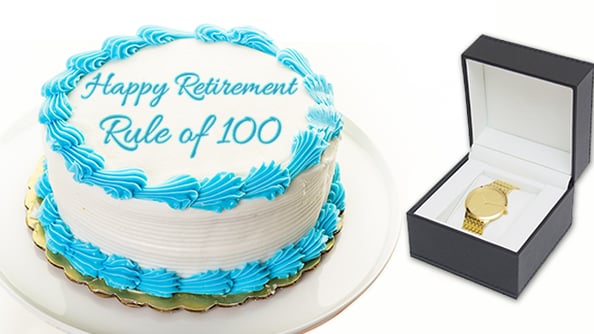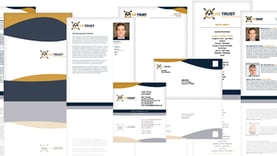A basic principle of investing is that you should gradually reduce your exposure to risk as you get older. Generally speaking, a younger investor has a longer time horizon and therefore can absorb more short-term investment risk. An older investor has a shorter time horizon and therefore doesn’t have as much time to absorb short-term investment risk.

Retire The Rule of 100
The Rule of 100 has been a popular rule of thumb used by financial services professionals throughout the industry. It is designed to provide guidelines for proper allocation of your client's retirement and investment assets. The rule suggests that an investor should hold a percentage of higher-risk investments like stocks equal to 100 minus their current age. The remaining percentage of their investments should be allocated to what are generally accepted as less-risky investments like high-grade bonds.
For example, a 65-year-old client following the "Rule of 100" should have 65% of his assets in less risky investments, and 35% of his assets in risky investments. On the other hand, an 80-year-old client following the "Rule of 100" would allocate 80% of her assets to less risky strategies, and only 20% of her assets towards higher risk strategies.
A Tool or a Crutch?
Financial professionals across the country lean on the "Rule of 100" and other one-size-fits-all plans to simplify asset allocation for their prospects and clients. Many of them actually believe this general rule of thumb. They have conviction about following the rule, and it is one of the guiding principles of their planning process.
While the "Rule of 100" may be an easy to explain sales story, does it really make sense? Who is this rule really serving? Is it simplifying the planning process for the investor? Perhaps. However, maybe, just maybe, this rule serves the lazy advisor who’s trying to sell his firm's services...
Age is Just One Number
I believe every retirement and investment dollar has a purpose. It's the dollar's purpose and time horizon that must be understood, not simply the age of the owner or the dollar. When it comes to retirement income planning, before any investment allocation recommendations may be made, we believe you need to know what each dollar's purpose is.
Specific retirement circumstances beyond the age of a client must be accounted for. The time horizon of a client's retirement dollar often has little to do with how old the person is, and more to do with when they need it. Retirement resources, including income sources like Social Security and pension income must coordinate with retirement assets like personal savings, IRAs, and employee sponsored defined contribution plans. Current living expenses must be adjusted for inflation and future expected and unexpected changes to expenses need to be planned for. The impact of taxes on various retirement assets cannot be ignored either as it may also play a significant role.
Importance of Limited Resources and Time
In the first example, our 65-year-old client is preparing to make the transition from earning a paycheck and saving for retirement, to having his retirement resources generate his retirement income. As part of an overall retirement income plan, he has elected to choose an optimal Social Security claiming strategy for his household. He understands that it’s the only source of government backed, inflation adjusted, tax advantaged income that he has access to. No advisor can sell him more, so he better get the most he can. By successfully executing the strategy, he will be able to cover 80% of his living expenses with his Social Security income within 5 years.
He wants to retire now, so he’ll need to bridge the gap between the earliest and optimal claiming strategy for he and his wife’s Social Security benefits. He’ll need to draw annual supplemental income for 5 years from his retirement resources in order to maintain their lifestyle. They will also need to supplement their income after executing their optimal claiming strategy. These dollars are not needed tomorrow, but they do need to be there beginning in 5 years. The total balance of the short-term retirement dollars needed, adjusted for a reasonable interest rate exceeds 65% of his total retirement assets.
Should he still adhere to the "Rule of 100" and place 35% of his already limited assets in higher risk strategies?
No! Although the owner is 65, these retirement dollars have a very specific purpose and a short time horizon. Exposure to market risk, and the negative impact of order of returns risk on these specific retirement dollars are significant. Those dollars cannot afford to be placed at risk. Substantial losses to his retirement accounts near this transitional period could be devastating.
Restricting Those Who Can Afford Risk
On the other hand, our 80-year-old client receives income from her deceased spouse’s Social Security check. He was the higher wage earner, and she inherited his benefits. He also left her his spousal pension benefit. Together, these two retirement income sources exceed her monthly expenditures. Although she has substantial retirement assets, she doesn't need them to supplement her retirement lifestyle.
If she has discretionary spending items that would exceed her income she may withdraw from her retirement resources. However, her day to day living expenses are more than adequately covered with guaranteed lifetime income. She could easily absorb significant market losses and never be forced to take a loss in order to maintain her lifestyle.
Should she adhere to the "Rule of 100" and have only 20% of her assets in higher risk strategies?
Probably not. The owner of the retirement dollars may be 80, but the retirement dollars themselves have a long time horizon. You could have a discussion with your client about wealth transfer and other efficient uses for these dollars. However, for the purpose of this discussion, these dollars don’t need to be held in conservative low risk investments.
Allocating Assets Properly is Key
I firmly believe that a client’s dollars should be allocated between various financial products, ranging from low-risk lower-return to high-risk higher potential return, depending on when they need the money, not based on how old the client is. Every single dollar of the client’s retirement assets has a purpose and a time frame. Money that is needed in order to supplement retirement income in the next 24 months has no business being invested in places that are either illiquid, or carry risk of loss.
Considering market cycles often materialize over a decade, money that is needed to supplement retirement income in the next 3 to 10 years may not need to be completely liquid, but shouldn't be subject to systemic market risk. Dollars that are not needed to supplement retirement income in the next 10 to 15 years or more could be allocated to high-risk positions in order to potentially receive a higher return. None of this has anything to do with how old the client is, and has everything to do with when their money is needed and for what purpose.
Avoiding Untimely Risk
Unfortunately, we find that many retirement savers approaching the transitional period between earning a paycheck and saving for retirement to having their retirement resources produce their retirement paycheck, have too much money allocated to high-risk investments. Many of them cannot afford to absorb a big market correction within five years before or five years after they plan to exit the workforce. Yet many of them have their retirement assets held within an employer sponsored retirement plan invested in positions with substantial systemic market risk.
A poorly timed bear market could have them facing unexpected consequences. They may have to drastically reduce their planned retirement lifestyle, or face the potential of running out of resources before they run out of breath. Of course, some may choose to continue to work until things improve. Many may not be given a choice at all as they are pushed out of the workforce for one reason or another.
Perhaps it is time to retire the "Rule of 100," and other general rules of thumb in the financial services profession.
Many advisors struggle with getting in front of the right target market for IUL. Download this valuable e-book "The Five Keys to Selling IUL Virtually" and you'll discover a better way to prospect and grow your business.






